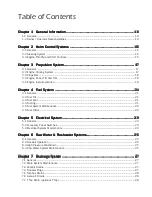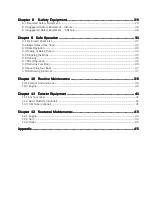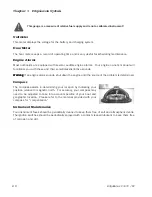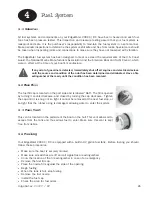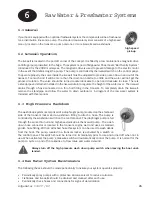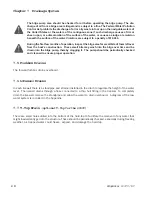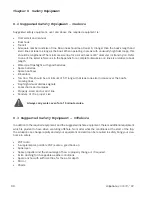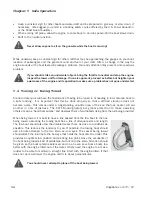
Chapter 3 Propulsion System
1 8
EdgeWater 200CC / DC
Do not run your outboard without water coming into the lower unit. The water pump impeller
can be damaged in only seconds of this type of operation.
3.3 Propellers
A turning propeller moves the boat through the water, forward
or backward. They should always be clean and free from nicks
or dings, which can adversely affect performance. Your dealer
can assist you in the proper selection of a propeller for your
boat. This selection is based on the horsepower of the engine
and its relationship to the size and weight of the boat.
Propeller sizes are determined by two numbers, which appear
on different propellers at various locations. They are listed in
sequence, for example 13 x 17. The first number is the diameter
of the propeller and the second is the pitch. Pitch is the
theoretical distance the propeller moves through the water with each complete revolution. The larger
the number the greater the theoretical movement. It also follows that the larger the number the greater
horsepower is required to turn it. With a load which is “normal”, or usual for your boating activities, the
engine should be able to reach its maximum operating RPM range at wide open throttle (WOT). With a
light load on smooth water, the engine should reach its manufacturer’s rated maximum operating RPM
at wide open throttle (WOT) and maximum trim. If it does not, you may have a propeller which has too
much pitch. If it goes beyond the maximum recommended RPM range, you may have too little pitch.
Neither condition is good for the engine. You will get shorter engine life and poorer performance than
your boat and motor were designed to provide.
If your boat came from the factory with a propeller selected by EdgeWater, it should already
be optimized for the performance of your boat. Before changing the pitch or diameter of
your propeller always check with your dealer to determine how the changes will affect your
boat and engine performance.
3.4 Engine Power Tilt and Trim
The power tilt and trim system on your outboard provides the ability
to optimize the running angle of your EdgeWater 200CC / DC to
allow for load and sea conditions. Moving the outboard lower unit
toward the transom is generally referred to as trimming “in”, while
moving the outboard lower unit away from the transom is referred
to trimming “out”. It is generally best to have the engine trimmed
in for acceleration from displacement to planning mode. This brings
the bow down and requires less fuel and effort on the engine’s
part to plane off the hull.
The first 20
o
of movement aft of the transom is referred to as
trim and is the area generally used to operate the boat while on
plane. The area beyond the first 20
o
is referred to as tilt and is
usually reserved for operating in shallow water or pulling up on a
beach.
Engine
Tilt
Max
Trim
Tilt
Under





